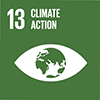Description/achievement of initiative
Water is widely used for the cooling down of thermal factories. The main objective of the DryRSP project is to design a dry cooling technology able to dissipate the waste heat without water consumption, allowing sub-cooling of the thermodynamic cycle below the dry-bulb temperature and eventually to produce water during night by condensation of the surrounding air humidity. Global warming which is particularly marked in the Arctic, can become more visible from the melting of glaciers and permafrost and therefore, from the rising level of oceans and freshwaters . Many studies have already demonstrated the importance of these continental inputs by major Arctic rivers, but few studies have focused on the contributions by coastal glaciers. ESCOFAR therefore aims at quantifying the flow of particulates and carbon released by several glaciers belonging to the Kongsfjorden fjord (Spitsbergen, Svalbard) in the summer. In the context of global warming, the project HEAT ADAPT (programme ANR) aims at exploring the regulation of gene expression in response to environmental inputs and has focused on those mechanisms allowing plants survival against environmental threats. These mechanisms also represent essential tools to ensure agricultural production in the upcoming years. As far as the course of study Sce Formation Continue for the class "Techniciens Installations Energies Renouvelables" is concerned, the University offers to its students the opportunity to work on the installation of a particular technology designed for production of solar hot water.Estimation of evolution trends of the CO2 system in the southern ocean. The goal of the MINERVE programme is the measuring of the variability of CO2 exchanges at the water-air interface, which is based on oceanographic cruises between Hobart (Australia) and Adelie Land (French base in Antarctica). The programme has observed the seasonal variations in the partial pressure of CO2 (pCO2), of total inorganic carbon and of total alkalinity in surface waters in association with hydrological and biogeochemical measurements taken in site and with satellite data (temperature, water colour). RV Astrolabe’s logistics trips enabled access to areas which have rarely been observed. This has helped better understand the processes explaining CO2 variations over time and space on a medium scale in Southern Ocean regions. Le projet "SESCO - Stockage thermique en chaleur sensible haute température sur modules stockeurs/échangeurs intégrés faits de vitrifiats issus de déchets amiantés" aimed at validating the recycled ceramics as TESM, identifying the proper refractory internal structure, controlling the formation of the proper structure during elaboration, optimizing the storage modules geometries at both lab. and industrial scales as well as the balance of the LCA analysis of the whole proposed approach. The project was running between 2009 and 2013.
Implementation methodologies
For the DryRSP Project, the adopted approach is based on the use of the already existing solar field of the plant as macro heat exchanger. This offers a huge heat transfer surface area available 24h a day for heat transfer with the surrounding air (mix convection for cooling) and with the extra atmospheric space at 3 K (radiative transfer for sub-cooling). This approach offers a new functionality to the solar field which represents currently 50% of the investment cost of a solar power plant. During night, when the solar field is not under power operation, the cooling effect can be stored to be used daily or (under favorable climate conditions) to be used to produce fresh water by condensation of the surrounding air humidity. As far as ESCOFAR is concerned, the geo-chemical tracing of several glaciers plumes should help monitor the spread of this continental source inside of a fjord and assess the impact it has on the sedimentation along the fjord. Combining these data with the ecological study of benthic fauna of the fjord. In the framework of the HEAT ADAPT, the study of the regulation of gene expression in response to environmental signals is fundamental for understanding how plants grow and develop. Climate experts predict a temperature increase of 1.5 to 5.8 ° C by 2100 which could result in a decrease from 15% to 50% of crop yields. Because of the exceptionally hot summers of the last few years, plants have already suffered from extreme temperatures which, combined with other factors, have had a negative impact on the global agricultural production. It is therefore urgent to understand how climate change affects the plant life cycle to quickly adapt agriculture to future temperature increases. There is a scarce knowledge of the molecular mechanisms helping plants survive to stress. The use of the technology for the production of solar hot water within the class "Techniciens Installations Energies Renouvelables" is possible thanks to the adoption of an innovative system called Cumusol.Concerning the MINERVE programme, the data collected during these cruises will provide the basis for estimating the inter-annual variability and the mean variation (trend) of the net CO2 flux at the ocean-atmosphere interface. The observations collected during the MINERVE cruises are also used by other teams to limit atmospheric models and validate biogeochemical ones based on general ocean circulation models which try to simulate the ocean carbon cycle over the medium and the long term.
Arrangements for Capacity-Building and Technology Transfer
Coordination mechanisms/governance structure
Partner(s)
Université de Perpignan Via Domitia


 2013
2013
 2015 (on an annual basis)
2015 (on an annual basis)
 2015 (ongoing)
2015 (ongoing)
 2016
2016
 2017
2017
 2018
2018
 Time-frame: 2014 - 2018
Time-frame: 2014 - 2018